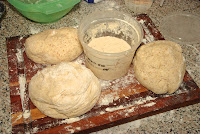This blog is in English to accommodate our friends in the English speaking world.
My bread-making experiments have now grown to include the making of my own yeast. None of this instant yeast stuff anymore!
 |
| The rye sourdough that started it all |
This specific recipe is not suited for making aboard a small vessel, as one needs an oven. If your boat has such, you are halfway there. The effort is not much and the results outstanding. Making small loaves perhaps helps with the handling of the loaves afterwards.
I started this yeast by putting half a cup of broken rye through the blender for about a minute. The resultant flour went into a container along with another half cup of white bread flour. To this lot was added a spoonful of honey and some warm water to make up a mushy dough. The water temperature was such that I could comfortably hold my finger in it. This concoction was then left for two days to start fermenting.
 | |
| The 3 mixes and their wild yeast |
The ciabatta was an experiment to see what comes out using different mixtures of flour. In this case I used one cup of flour per type. There were three types, one using white bread flour only, one using a 50/50 mix of white and brown bread flour, and the last one was 25% rye, 25% brown and 50% white bread flour.
 | |
| The three mixes after a night's rest. |
 | |
| Good yeast development after a night's rest |
 | |
| Fermentation bubbles |
The result was ciabatta that I could not believe! Perhaps slightly overbaked, but very tasty and chewy. There is also a slight sour taste of the yeast, adding a wonderful flavour to the bread. These loaves are quite heavy and one slice per person keeps away the pangs of hunger a lot longer than the local commercial bread. We had some of these with cheese and wine for a Saturday night dinner. Needless to say, the salt crackers were left uneaten on the board!
Authored by Johan Zietsman
Last updated on 2012-12-12



No comments:
Post a Comment